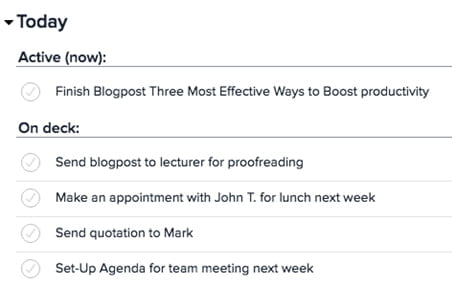
Ever have one of those days when you wake up ready to conquer the world, and go to bed feeling like the world conquered you?
You know the feeling: Grand plans derailed due to an urgent email, phone call, or crisis.
If your time is at the whim of sudden, urgent events, you’re reactive; and reactivity rarely leads to good long-term decisions.
That’s the bad news. Here’s the good news: Becoming less reactive and more proactive isn’t difficult. But before we get there, let’s make sure you understand the difference between the two.
Are you riding a rocking horse or a stallion?
When you’re proactive, you’re in control. Sure, unexpected things might happen. But you decide how to react and how to move forward.
When you’re reactive, circumstances are in control. Your day-to-day operations are dictated by urgent, unproductive influences and you can’t seem to say no.
What makes reactivity so dangerous is that it feels productive. After all, you’re still getting things done: You responded to 32 emails, personally handled a customer’s self-proclaimed crisis, and worked with your assistant to reschedule a couple meetings.
But “getting stuff done” and “moving forward” are two different things; like the difference between motion and progress.
For example, imagine riding a rocking horse: You’re constantly moving, but never going anywhere. Compare that to riding stallion, moving purposely and powerfully.
Reactive people ride rocking horses; proactive people ride stallions. Both move, but only one moves forward. Who do you think wins the race?
Reactive people ride rocking horses; proactive people ride stallions. Both move, but only one moves forward. Tweet this!
Winning the race in three steps
John Wooden, arguably one of the best college basketball coaches in recent history, once said, “It’s the little details that are vital. Little details make all the difference.”
That’s true in basketball, it’s true in business, and it’s true in life. Massive improvement is rarely the result of massive change. More often, it’s the result of small changes made consistently.
That’s what we’re going to talk about today: Three small changes you can make today to reap the rewards tomorrow.
Ready to stop rocking and start galloping? Let’s take a look.
Massive improvement is rarely the result of massive change. It’s the result of small changes made consistently. Tweet this!
Change #1: Create a task management system
What dictates your to-do list?
If you’re like most people, your daily tasks are determined by your most recent emails. And yes, there will be urgent emails that need immediate attention.
But, for the most part, you do more harm than good when you base the entirety of your schedule around your inbox. (That’s why we recommend outsourcing your inbox)
Instead, adopt a proactive task management approach that you control. There are countless solutions out there but, at MindMaven, we highly recommend Asana.
Here’s an example of Asana’s task management in action:

If software isn’t your thing, do it the old-fashioned way: Pen and paper. In the end, the medium doesn’t matter. What’s important is that it’s a system you have complete control over.
Change #2: Plan your day in advance
Once you have a task management approach, create a specialized “Today” section for tasks that need to be completed within the next 24 hours. Then prioritize those tasks by order of importance.
Sound easy? Here’s the catch: Your daily to-do list should never be longer than seven tasks.
Once you’ve got a “Today” section, also create an “Upcoming” section. As new tasks come in, fight the urgent to add them to your “Today” list unless they’re truly important and urgent. Otherwise they should be added to “Upcoming” and moved up as you complete “Today” tasks.
For some of you, this is going to be hard. That’s good; it means you’re teaching yourself to prioritize. Stick with it and you’ll discover that a seven-item to-do list is almost always more productive than a 50-item list.
Change #3: Create a progress-driven morning routine
What’s the first thing you do when you wake up? If you’re like most people, you check your email. But as we already discussed, the inbox is the quickest path to reactivity.
Let’s try something new. Instead of checking your emails or hitting “snooze” for the 5th time, create a 5-minute morning routine. Here’s an example of what that tactical routine might look like:

If you’re more of a “hit the ground running”-type in the morning, you might be tempted to skip this step. Don’t. Turn this into a habit and it will become the most valuable part of your day.
The 14-day proactivity challenge
These three steps might seem too simple to make a difference, but remember: Small changes, made consistently, create dramatic improvement.
So I challenge you to find an accountability partner and give this a try for two weeks. If you don’t notice a difference in the next 14 days, forget it. But when you do notice a difference (and you will), come back and share your experience in the comments below.
Sound good? Great! Announce your commitment to the challenge in the comments, then get started! I’ll look forward to your success stories.

